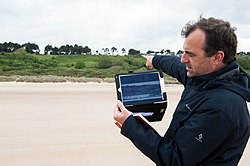Career
Kershaw's journalism has appeared in many magazines and newspapers since 1990, varying from investigative pieces and reportage to interviews with subjects ranging from Frank Zappa, [3] Alger Hiss and Garry Kasparov to the boxer Max Schmeling and dozens of World War II veterans. [4]
The Bedford Boys
While writing a 2002 biography, Blood and Champagne, [5] about Robert Capa, the celebrated war photographer, [6] Kershaw came across the story of Bedford, Virginia and its sacrifice on D-Day, 6 June 1944, on Dog Green sector of Omaha beach. The resulting book, The Bedford Boys, 2003, became a New York Times best-seller. [7]
The Longest Winter, The Few, Escape from the Deep
Kershaw's next book, about the Battle of the Bulge, The Longest Winter , 2004, focused in particular on World War II's most decorated platoon, an I&R unit commanded by 20-year-old Lyle Bouck Jr. of the 99th Infantry Division. [8] It was followed by other titles: The Few, 2006, the story of eight American pilots who fought illegally in the Battle of Britain; [9] Escape from the Deep, 2008, the tale of the only successful escape from a submerged American submarine, the USS Tang, without surface assistance in late October 1944; [10] and The Envoy, 2010, an account of Raoul Wallenberg's rescue efforts in Hungary during the Holocaust, based on extensive interviews with survivors saved by Wallenberg. [11]
Television and film
Kershaw has also worked as a screenwriter and in television, [12] penning an award-winning 2004 documentary for Arte on Bobby Kennedy. [13] Several of his books have been optioned by Hollywood, including The Few which was selected as the Military Book Club's first-ever book of the year in 2006. [14] Kershaw has appeared as a narrator in several documentaries, including the "Battle of the Bulge" episode of When Weather Changed History, "WWII IN 3D", [15] the History Channel's "The Last Days of WWII", [16] 2014's PBS Masters' 200th anniversary episode, "Salinger", [17] and PBS's "D-Day 360". [18]
The Liberator
His 2012 book, The Liberator: One World War II Soldier's 500-Day Odyssey from the Beaches of Sicily to the Gates of Dachau, tells the story of Texas-born Felix Sparks, an officer in the 157th Infantry Regiment of the 45th Infantry Division, who participated in four amphibious invasions in Europe and commanded the Thunderbird unit that liberated Dachau on 29 April 1945. [19] It has been praised for its gritty realism [20] and described by the Wall Street Journal as an "exceptional chronicle of one soldier's experience in WWII." [21]
Netflix released The Liberator as a four hour series, penned by Jeb Stuart, in November 2020. [22]
Avenue of Spies and The First Wave
Kershaw's Avenue of Spies, a New York Times best seller, published in August 2015, tells the story of the Avenue Foch in Paris in World War II, focusing in particular on Gestapo officer Helmut Knochen and an American doctor and his family. [23] Kershaw's most recent book, The First Wave, a national best-seller, was published in 2019 to mark the 75th anniversary of D Day.
Lecturing and battlefield touring
Since 2012, Kershaw has led many battlefield tours of Europe. He has an honorary doctorate in military history from Norwich University and is a Board director of Friends of the National WWII Memorial. [24] He also appears at conferences and events, in particular to commemorate the Second World War. [25]
